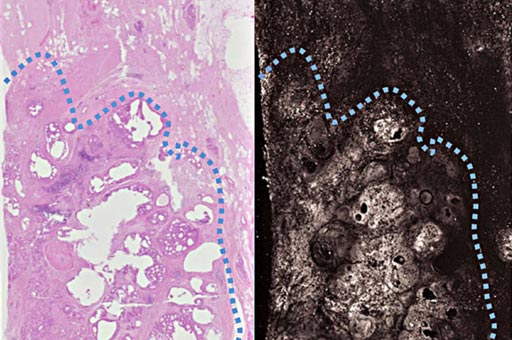Photoacoustic Imaging Ensures Complete Cancer Removal
By MedImaging International staff writers
Posted on 14 Jun 2017
A novel technology that combines light and sound can scan tissue samples to produce images detailed and accurate enough to determine whether a tumor has been completely removed.Posted on 14 Jun 2017
Developed by researchers at Washington University School of Medicine (WUSTL; St. Louis, MO, USA), and the California Institute of Technology (Caltech; Pasadena, USA) photoacoustic microscopy (PAM) can scan an unprepared sample of breast tissue in the operating theater, producing images of sufficient quality to detect tumor features and margins. PAM takes advantage of the intrinsic optical contrast of breast tissue in order to achieve multilayered, histology-like imaging of the tissue surface.

Image: Photoacoustic imaging (R) produces images as detailed and accurate as traditional methods (L) (Photo courtesy of Terence Wong / WUSTL).
According to the researchers, the high correlation of the PAM images to conventional histologic images allows rapid computations of diagnostic features such as nuclear size and packing density, potentially identifying small clusters of cancer cells. And since PAM does not require tissue processing or staining, it can be performed promptly and intraoperatively, enabling immediate directed re-excision, reducing the number of second surgeries. The study was published on May 17, 2017, in Science Advances.
“Overall, the photoacoustic images had a lot of the same features that we see with standard staining, which means we can use the same criteria to interpret the photoacoustic imaging. We don’t have to come up with new criteria,” said co-senior author Deborah Novack, MD, PhD, of WUSTL. “It’s the pattern of cells – their growth pattern, their size, their relationship to one another – that tells us if this is normal tissue or something malignant.”
“All molecules absorb light at some wavelength; this is what makes photoacoustic imaging so powerful. Essentially, you can see any molecule, provided you have the ability to produce light of any wavelength,” said co-senior author biomedical engineering Lihong Wang, PhD, of Caltech. “None of the other imaging technologies can do that. Ultrasound will not do that; X-rays will not do that; light is the only tool that allows us to provide biochemical information.”
Photoacoustic imaging uses non-ionizing laser pulses delivered into biological tissues. Some of the delivered energy is absorbed and converted into heat, leading to transient thermoelastic expansion, and thus wideband ultrasonic emission, which can be detected by ultrasonic transducers and analyzed to produce images. The magnitude of the photoacoustic signal is proportional to local energy deposition, which can be demonstrated by optical absorption contrast on the images of the targeted areas.
Related Links:
Washington University School of Medicine
California Institute of Technology














